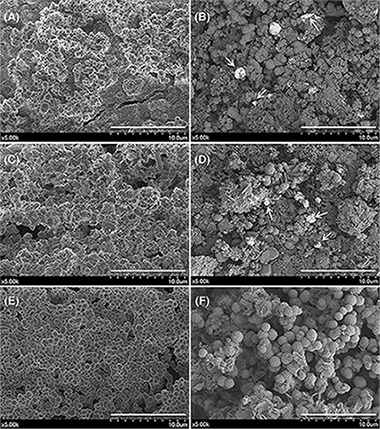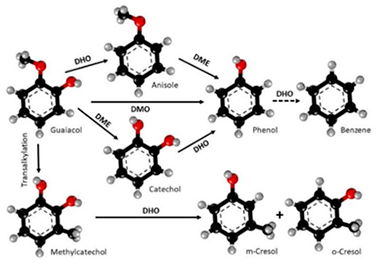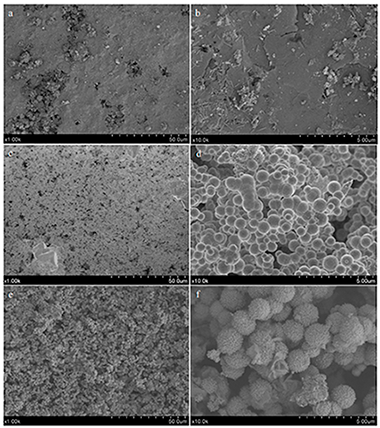Artículos SCI
2019
2019
Química de Superficies y Catálisis
Carbon Supported Gold Nanoparticles for the Catalytic Reduction of 4-Nitrophenol
Molina, HR; Munoz, JLS; Leal, MID; Reina, TR; Ivanova, S; Gallego, MNC; Odriozola, JAFrontiers in Chemistry, 7 (2019) 548
Show abstract ▽
This work is a detailed study on how to optimize gold colloids preparation and their deposition to very different in nature carbon materials. The change of the continuous phase and its dielectric constant is used to assure the good dispersion of the hydrophilic/hydrophobic carbons and the successful transfer of the preformed small size colloids to their surface. The sintering behavior of the particles during the calcination step is also studied and the optimal conditions to reduce to a minimum the particle size increase during the protecting agent removal phase are found. The as prepared catalysts have been tested in a relevant reaction in the field of environmental catalysis such as the reduction of 4-nitrophenol leading to promising results. Overall, this work proposes an important methodology to follow when a carbonaceous material are selected as catalyst supports for green chemistry reactions.
Agosto, 2019 | DOI: 10.3389/fchem.2019.00548
Materiales para Bioingeniería y Regeneración Tisular
Higher hydration performance and bioactive response of the new endodontic bioactive cement MTA HP repair compared with ProRoot MTA white and NeoMTA plus
Jimenez-Sanchez, Maria Del Carmen; Segura-Egea, Juan Jose; Diaz-Cuenca, AranzazuJournal of biomedical materials research. Part B, Applied biomaterials, 107 (2019) 2109-2120
Show abstract ▽

The aim of this study was to characterize the hydration performance and the bioactive response of the new bioactive endodontic cement MTA HP repair (HP), comparing its physicochemical parameters with those of ProRoot MTA White (Pro) and NeoMTA Plus (Neo). Un-hydrated precursor materials were characterized by X-ray fluorescence, laser diffraction, N2 physisorption and field emission gun scanning electron microscopy (FEG-SEM). Setting time was assessed according to ASTM specification C 266. Hydrated materials were analyzed by X-ray diffraction, Fourier transform infrared spectroscopy (FT-IR) and (FEG-SEM). Bioactivity evaluation in vitro was carried out, by soaking processed cement disk in simulated body fluid (SBF) during 168 h. The cements surface was studied by FT-IR, FEG-SEM, and energy dispersive X-ray. Release to the SBF media of ionic degradation products was monitored using inductively coupled plasma atomic emission spectroscopy. HP showed shorter initial setting time compared to Pro and Neo and produce a quick and effective bioactive response in vitro in terms of phosphate phase surface coating formation. This higher bioactive response for HP is correlated with increasing calcium aluminate content, increasing surface area of un-hydrated powder precursor and the increasing release capacity of Si ionic products of the final hydrated product. The higher bioactive response of MTA HP repair highlights this material, as very interesting to further investigate its performance to improve the outcome of vital pulp therapy procedures.
Agosto, 2019 | DOI: 10.1002/jbm.b.34304
Química de Superficies y Catálisis
Noble Metal Supported on Activated Carbon for "Hydrogen Free" HDO Reactions: Exploring Economically Advantageous Routes for Biomass Valorisation
Jin, W; Santos, JL; Pastor-Perez, L; Gu, S; Centeno, MA; Reina, TRChemcatchem (2019) 4434-4441
Show abstract ▽

An innovative route for bio‐compounds upgrading via “hydrogen‐free” hydrodeoxygenation (HDO) is proposed and evaluated using guaiacol as a model compound in a high‐pressure batch reactor. Experimental results showed that noble metal supported on activated carbon catalysts are able to conduct tandem multiple steps including water splitting and subsequent HDO. The activity of Ru/C catalyst is superior to other studied catalysts (i. e. Au/C, Pd/C and Rh/C) in our water‐only HDO reaction system. The greater dispersion and smaller metal particle size confirmed by the TEM micrographs accounts for the better performance of Ru/C. This material also presents excellent levels of stability as demonstrated in multiple recyclability runs. Overall, the proposed novel approach confirmed the viability of oxygenated bio‐compounds upgrading in a water‐only reaction system suppressing the need of external H2 supply and can be rendered as a fundamental finding for the economical biomass valorisation to produce added value bio‐fuels.
Agosto, 2019 | DOI: 10.1002/cctc.201900841
Structural and compositional analysis of Co-based coatings after catalytic tests for the sodium borohydride hydrolysis
Beltran, AMMaterials Research Express, 6 (2019) art. 085511
Show abstract ▽
The use of Co-based catalysts for the sodium borohydride hydrolysis for hydrogen production is a well-known process as a source of clean energy, although its mechanisms are still under discussion. With the aim of acquiring a deeper knowledge about this catalytic process, three different catalysts (Co, CoC and CoB) were deposited as a thin film layer by magnetron sputtering onto a polymeric membrane, used as a substrate and analyzed by advance transmission and scanning-transmission electron microscopy techniques (STEM). Structural and compositional characterizations, by electron energy loss spectroscopy (EELS), have been performed on the coatings before and after their use as catalysts on the sodium borohydride reaction for 90 min, to check the production of hydrogen. Results have shown the formation of CoxB nanoflakes and other Co-based compounds over the catalysts and related to their catalytic activity. Knowing the changes in the structure and composition of the catalysts is key to understanding their catalytic behavior, activity and durability. Among the analyzed catalysts, the Co-C presents better activity during the first cycles, which is related to a larger formation of CoxB.
Agosto, 2019 | DOI: 10.1088/2053-1591/ab1e27
Materiales para Bioingeniería y Regeneración Tisular
MTA HP Repair stimulates in vitro an homogeneous calcium phosphate phase coating deposition
Jiménez-Sánchez, M.D.C.; Segura-Egea, J.J.; Díaz-Cuenca, A.Journal of Clinical and Experimental Dentistry, 11 (2019) e322-e326
Show abstract ▽

Background: To study the mineralization capacity in vitro of the bioceramic endodontic material MTA HP Repair. Material and Methods: Bioactivity evaluation in vitro was carried out, by soaking processed cement disk in simulated body fluid (SBF) during 168 h. The cement surface was studied by Fourier transform infrared spectroscopy (FTIR), field emission gun scanning electron microscopy (FEG-SEM) and energy dispersive X-ray analysis (EDX). Release to the SBF media of ionic degradation products was monitored using inductively coupled plasma atomic emission spectroscopy (ICP-AES). Results: FT-IR showed increasing formation of phosphate phase bands at 1097, 960, 607 and 570 cm -1 with prolonged SBF soaking. FEG-SEM analysis reveals that HP produces a effectively surface covering consisting in homogeneous spherical phosphate phase aggregates with an average diameter of 0.5 -1 .0 μm. EDX analysis comparing un-treated (hydrated), 24 h and 72 h SBF treated surfaces of MTA HP Repair revealed phosphate deposition after 24 h, with high phosphorous/silicon element ratio signal measured after 24 h, indicating a very high phosphate phase deposition for this material. Conclusions: The study shows that MTA HP Repair produces a quick and effective bioactive response in vitro in terms of crystalline calcium phosphate surface coating formation. The high bioactive response of MTA HP Repair makes it an interesting candidate for endodontic use as repair cement.
Agosto, 2019 | DOI: 10.4317/jced.55661
- ‹ anterior
- 120 of 411
- siguiente ›














